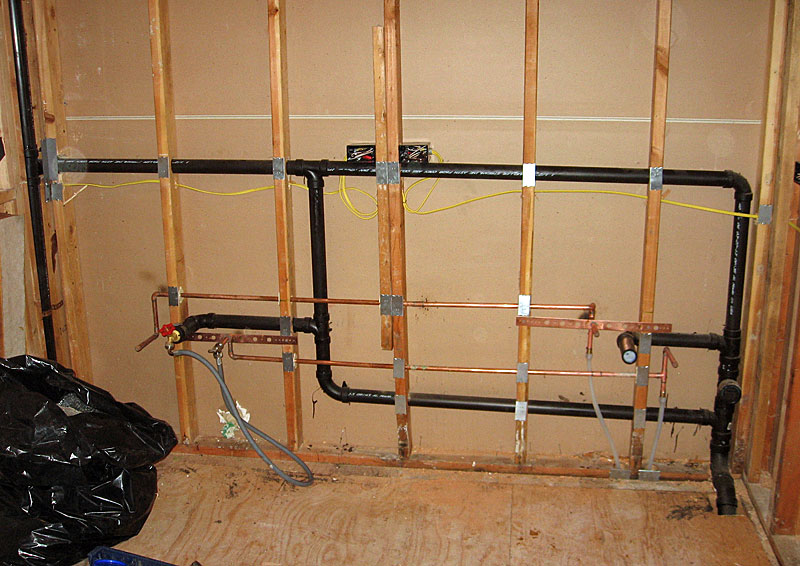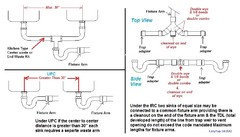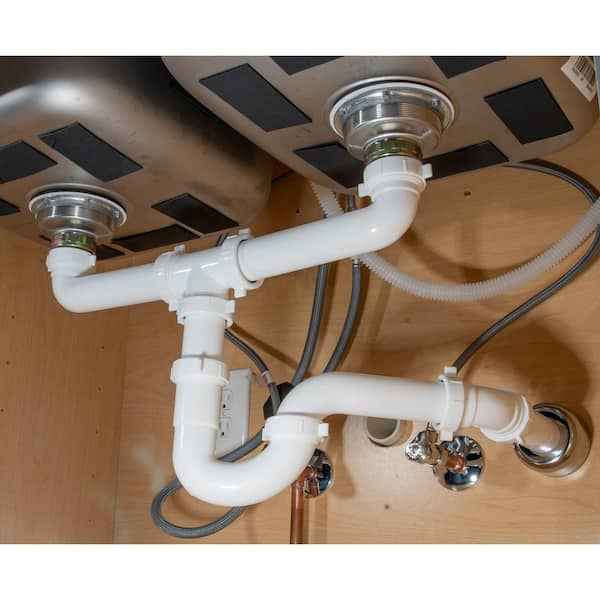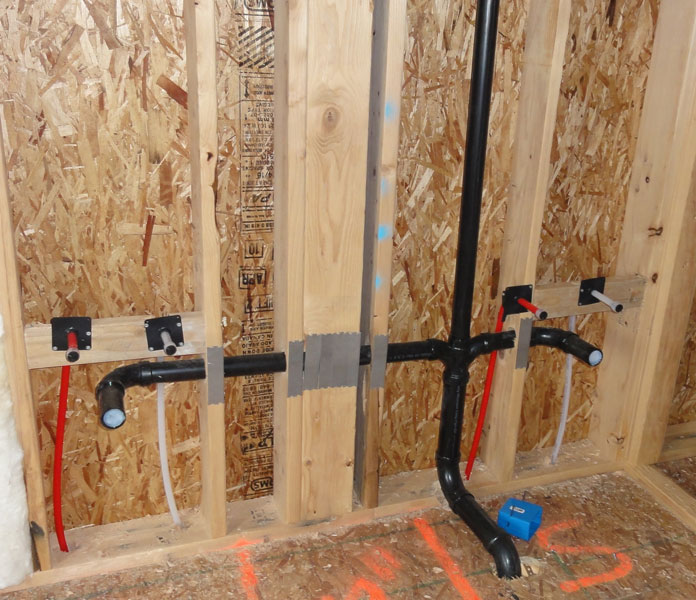A Dual Bathroom Sink Plumbing Diagram Explained
Dual bathroom sinks have become increasingly popular in modern homes, offering convenience and functionality. To understand how these plumbing systems work, it’s important to familiarize yourself with the basics of a dual bathroom sink plumbing diagram. We will explore the different components and connections involved in this system.
- Sink Drains: The first component of a dual bathroom sink plumbing system is the sink drains. Each sink has its drain pipe that connects to the main drain line. The drains are typically equipped with a trap, which prevents sewer gases from entering the bathroom. Understanding the layout of these drains is crucial for proper installation and maintenance.
- Water Supply Lines: In addition to the drains, dual bathroom sinks require separate water supply lines. These lines connect the sinks to the main water supply, allowing for hot and cold water to be easily accessed. It’s important to ensure that the supply lines are properly connected and that the water flow is balanced between the two sinks.
- Ventilation: Proper ventilation is essential in any plumbing system, including dual bathroom sinks. A vent pipe is necessary to allow air to escape from the drain lines, preventing the buildup of negative pressure and facilitating smooth drainage. Understanding the location and function of the vent pipe is crucial for preventing clogs and ensuring efficient operation.
- P-traps: P-traps are an important component of a dual bathroom sink plumbing system. These curved pipes are located beneath the sinks and are designed to trap a small amount of water, creating a seal that prevents sewer gases from entering the bathroom. Regular inspection and cleaning of the P-traps are necessary to maintain proper functionality.
- Overflow Drainage: Some dual bathroom sinks are equipped with overflow drains, which prevent water from overflowing onto the countertop. These drains are connected to the main drain line and play a crucial role in preventing water damage. Understanding the location and function of the overflow drains is important for proper installation and maintenance.

Installing a Dual Bathroom Sink Plumbing System
Installing a dual bathroom sink plumbing system can seem like a daunting task, but with the right guidance, it can be a rewarding DIY project. Here is a step-by-step guide to help you successfully install a dual bathroom sink plumbing system.
Gather the Necessary Tools and Materials: Before you begin the installation process, gather all the necessary tools and materials. This may include a pipe cutter, adjustable wrench, PVC pipes, fittings, P-traps, and water supply lines. Ensure that you have everything you need to complete the project without interruptions.
Turn Off the Water Supply: Before starting any plumbing project, it’s crucial to turn off the water supply to avoid any accidents or water damage. Locate the main shut-off valve and close it to stop the flow of water to the bathroom. This will allow you to work safely and without any interruptions.
Remove the Existing Sink: If you’re replacing an existing sink, start by disconnecting the water supply lines and drain pipes from the old sink. Use a pipe cutter or adjustable wrench to remove any necessary fittings or connections. Carefully remove the sink from the countertop, ensuring not to damage any surrounding fixtures or surfaces.
Install the Dual Sink: Once the old sink is removed, it’s time to install the new dual sink. Follow the manufacturer’s instructions for proper installation. Ensure that the sink is properly aligned and securely attached to the countertop. Double-check the measurements and make any necessary adjustments before proceeding.
Connect the Drain Pipes and Water Supply Lines: With the sink in place, it’s time to connect the drain pipes and water supply lines. Measure and cut the PVC pipes to the appropriate length, and use fittings and P-traps to connect the pipes to the sink drains. Connect the water supply lines to the corresponding hot and cold water valves.
Test the System: Once all the connections are made, it’s important to test the system for any leaks or issues. Turn on the water supply and inspect for any signs of leakage. Check the drains for proper drainage and ensure that the water flow is balanced between the two sinks. Make any necessary adjustments or repairs as needed.
Tips for Selecting Plumbing Components for Dual Sinks
When it comes to selecting plumbing components for a dual bathroom sink, choosing the right materials is crucial for long-lasting and efficient operation. Below we provide some tips to help you select the right materials for your dual sink plumbing system.
Consider the Material of the Pipes: One of the most important aspects of selecting plumbing components is choosing the right material for the pipes. PVC (polyvinyl chloride) pipes are a popular choice for their affordability and ease of installation. However, if you prefer a more durable and corrosion-resistant option, consider using copper or stainless steel pipes.
Look for Quality Fittings and Connectors: Fittings and connectors play a crucial role in ensuring proper connections and preventing leaks in your dual sink plumbing system. Opt for high-quality fittings and connectors that are specifically designed for dual sink installations. Look for features such as tight seals, easy installation, and durability to ensure a reliable plumbing system.
Check for Water Supply Line Compatibility: When selecting water supply lines for your dual sink, it’s important to ensure compatibility with your existing plumbing system. Check the size and type of your existing water supply lines and choose supply lines that match these specifications. This will ensure a proper and secure connection, minimizing the risk of leaks or water pressure issues.
Consider the Drainage System: The drainage system is another important aspect to consider when selecting plumbing components for your dual sink. Choose P-traps and drain pipes that are specifically designed for dual sinks. Ensure that the components are the correct size and properly aligned to prevent clogs and ensure efficient drainage.
Take Style and Design into Account: While functionality is key, don’t forget to consider the style and design of your plumbing components. Dual sinks offer a great opportunity to enhance the visual appeal of your bathroom. Look for components that match your overall bathroom aesthetic and complement the style of your sinks and countertops.
Common Issues and Troubleshooting
While dual bathroom sink plumbing systems offer convenience and functionality, they can sometimes encounter issues that require troubleshooting and repairs. Here are some common problems that may arise in dual sink plumbing and provide troubleshooting tips to help you fix them.
Slow Draining: One of the most common issues in dual sink plumbing is slow draining. This can be caused by a clog in the drain pipes or P-traps. Start by using a plunger to attempt to dislodge the clog. If that doesn’t work, try using a drain snake or a mixture of baking soda and vinegar to dissolve the clog. If the problem persists, it may be necessary to call a professional plumber.
Leaks: Leaks can occur in various areas of the dual sink plumbing system, including the drain pipes, water supply lines, and fittings. Start by visually inspecting the connections and fittings for any signs of leakage. Tighten any loose fittings and replace any damaged or worn-out components. If the leak persists, it’s best to seek professional help to identify and fix the underlying issue.
Uneven Water Flow: Uneven water flow between the two sinks can be a frustrating problem. This can be caused by an issue with the water supply lines or an imbalance in the water pressure. Check the water supply lines for any obstructions or kinks. If the issue persists, it may be necessary to install pressure-balancing valves to ensure an even distribution of water flow.
Sewer Odors: If you’re encountering unpleasant sewer odors in your bathroom, it may be due to a problem with the P-traps. Ensure that the P-traps are properly sealed and that there is water in them to create a barrier against sewer gases. If the odor persists, it may be necessary to clean or replace the P-traps to eliminate the issue.
Water Hammer: Water hammer refers to the loud banging noise that can occur when water flow is abruptly stopped. This can be caused by improper installation or air trapped in the pipes. Install water hammer arrestors near the shut-off valves to alleviate the issue. If the problem continues, it’s best to consult a professional plumber for further assistance.
How Dual Sink Plumbing Can Improve Functionality and Style
Upgrading your bathroom is an exciting project that can enhance both the functionality and style of the space. One way to achieve this is by installing a dual sink plumbing system. Let’s see how dual sink plumbing can improve the functionality and style of your bathroom.
Increased Convenience: One of the primary benefits of a dual sink plumbing system is the increased convenience it offers. With two sinks, multiple users can simultaneously use the bathroom without any conflicts or delays. This is particularly beneficial in busy households or shared bathrooms, as it eliminates the need to wait for one person to finish before the other can use the sink.
Enhanced Organization and Storage: Dual sinks provide ample countertop space, allowing for better organization and storage in the bathroom. With two sinks, you can have separate areas for each user’s personal items, such as toothbrushes, toiletries, and cosmetics. This eliminates clutter and promotes a more organized and efficient bathroom space.
Improved Functionality: Dual sink plumbing systems typically come with additional features that enhance functionality. For example, you can opt for sinks with built-in soap dispensers, touchless faucets, or integrated storage solutions. These features not only improve the overall functionality of the sinks but also add convenience and ease of use to your daily routine.
Enhanced Aesthetics: Dual sink plumbing systems can greatly enhance the aesthetics of your bathroom. With a wide range of sink styles, materials, and finishes available, you can choose sinks that complement your bathroom’s design theme and create a cohesive look. Dual sinks can serve as a focal point, adding a touch of elegance and sophistication to the space.
Increased Property Value: Investing in a dual sink plumbing system can also increase the value of your property. Dual sinks have become a sought-after feature in modern bathrooms, and potential buyers often consider them a desirable upgrade. By incorporating dual sinks into your bathroom, you can potentially attract more buyers and increase the overall value of your home.
two-sink vanity plumbing – Fine Homebuilding
Bathroom – Converting from double sink vanity to single
Plumbing: Can I hook up a double bathroom sink to a single drain
How To Plumb a Bathroom (with multiple plumbing diagrams
Everbilt 1-1/2 in. 45-Degree White Plastic Double Slip-Joint Sink
Double sink rough in. . . Terry Love Plumbing Advice u0026 Remodel
Water backup on new double vanity/both sides – Home Improvement
Double Bathroom Sink – Two Different Rough Plumbing Drain Methods
Related Posts:
- Bathroom Sink Not Draining Fast Enough
- White Vitreous China 18 Inch Vessel Bathroom Sink
- Ada Compliant Commercial Bathroom Sinks
- Large Rectangular Undermount Bathroom Sink
- Bathroom Sink Remodel
- Gold Taps For Bathroom Sink
- Bathroom Sink Doesn T Drain
- How To Clean Bathroom Sink Plug Hole
- How To Clean Your Bathroom Sink Drain
- Bathroom Sink Mixer Taps











